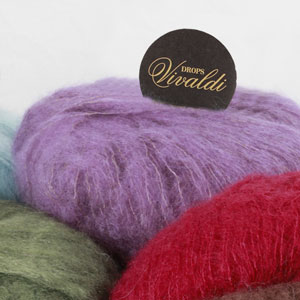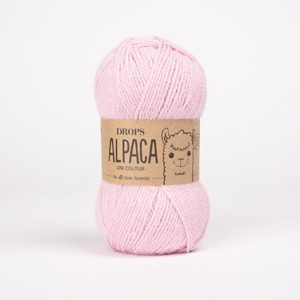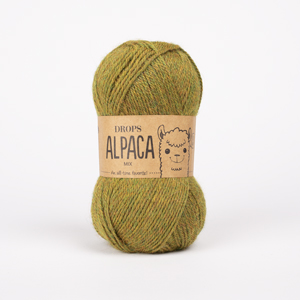Comments / Questions (66)
![]() Maribel wrote:
Maribel wrote:
Que significa p e en ganchillo?
15.04.2024 - 00:45
![]() Adele wrote:
Adele wrote:
How many chains under the arm holes?
07.03.2022 - 14:04DROPS Design answered:
Dear Adele, you are working size S/M, correct? you dont crochet any chains under armhole, just work: first 4 tr-group as before, skip 5 tr group for the sleeve, work as before the next 7 tr-groups, skip 5 tr group for the sleeve and crochet the last 4 tr-groups. Happy crocheting!
08.03.2022 - 10:49
![]() Adele wrote:
Adele wrote:
I am having trouble understanding where to do the increase in row 5 of s/m size... "5th row in tr-group: Inc 2 tr-groups on each side in 6th ch loop from mid front = 25 tr-groups and 24 ch loops." Is the 5th row increase done in between the increases of row 4 or inside the 4 chain of the increase of row 4? Please help. Adele
06.03.2022 - 05:09DROPS Design answered:
Dear Adele, for the 5th increase row, you increase in the 6th 4-ch-space from the beginning of the row and in the 6th 4-ch-space before the end of the row by working 3 tr-groups (instead of just 1). Happy crocheting!
07.03.2022 - 08:46
![]() Vivian Petersen wrote:
Vivian Petersen wrote:
Please tell me which single yarn to substitute for the Alpaca and the Vivaldi mix for the Nearly Spring pattern. Please don't refer me to the links I just ask you to tell me directly. Thank you.
27.12.2021 - 05:16DROPS Design answered:
Hi Vivian, you can use one single thread of DROPS Melody. Happy crocheting!
28.12.2021 - 10:22
![]() Nadia wrote:
Nadia wrote:
Hello, Increasing tip 1&2: Increase extra dtr-group, with 4ch in between one ch loop. What is this one ch loop? There are always 4ch between every dtr group, so I don’t understand this 4ch in between one ch loop. Thank you in advance for your answer.
25.01.2020 - 01:48DROPS Design answered:
Dear Nadia, 1 ch-loop is 1 ch-space, ie the 4 chains between the dtr groups. You have to crochet 4 dtr around the 4-chain-space; to increase 1 dtr group, you will crochet 4 dtr, 4 ch, 4 dtr in the same ch-space; to increase 2 dtr-groups you will crochet 4 dtr, 4 ch, 4 dtr, 4 ch, 4 dtr in each dtr group. Happy crocheting!
27.01.2020 - 08:10
![]() Sibolien wrote:
Sibolien wrote:
Graag zou ik willen weten wat voor alternatief garen ik kan gebruiken voor het haken van het hesje. Het hesje wil ik graag haken met 1 garen.
06.04.2018 - 20:34DROPS Design answered:
Dag Sibolien, Je kunt hiervoor een garen kiezen uit garengroep D. Alpaca valt namelijk in garengroep A en Vivaldi valt in garengroep C. 1 draad van A plus 1 draad van C komt overeen met 1 draad van D.
08.04.2018 - 18:27
![]() Åsa wrote:
Åsa wrote:
Hej Om jag fattar rätt så ska jag använda båda garnsorterna hela tiden.. Hur kan då förbrukningen vara 150 gr av det ena men bara 100 gr av det andra garnet? Borde det inte gå åt lika mycket av varje? Vill gärna ha svar för att kunna köpa rätt mängd / färgbad. Tack//Åsa
15.02.2018 - 09:32DROPS Design answered:
Garnmängden i mönstret är korrekt. Orsaken till att det går åt ett nystan mindre av Vivaldi är att metermängden är större på detta garn än på Alpaca.
15.02.2018 - 14:28
![]() Anke Visser wrote:
Anke Visser wrote:
Ik maak maat s/m. Ik haak met katoen. Stekenproef klopte en ook de lengte van deel 1 (15 cm). Bij deze maat is het mouwtje erg strak. Ik heb nog een extra ketting van vier lossen gemaakt onder de arm om het mouwtje iets groter te maken. Ook dit is nog te krap. Ik raad mensen met maat s/m aan maat L te haken. Verder is het patroon prima, mede dankzij de vragen en opmerkingen van anderen. Misschien goed om aan te vullen dat het patroon in een stuk wordt gehaakt en uitleg over middenvoor.
16.05.2017 - 22:47
![]() Elizabeth wrote:
Elizabeth wrote:
How do I start row 3?
18.11.2016 - 02:33DROPS Design answered:
Dear Elizabeth, read diagram from the left towards the right from WS, ie on row 3 in diagram (= row 2 in Diag.1), work 4 ch, 1 sc in next tr, ... Happy crocheting!
18.11.2016 - 13:04
![]() ISABELLE PEREZ wrote:
ISABELLE PEREZ wrote:
Bonjour, La laine Drops Vivaldi est introuvable, par quoi peux t on la remplacer svp ?
06.10.2016 - 09:54DROPS Design answered:
Bonjour Mme Perez, à la place de Vivaldi, vous pouvez utiliser 2 fils Kid-Silk (ex ici ou 1 fil Brushed Alpaca Silk. Vous trouverez ici plus d'infos à ce sujet. Bon crochet!
06.10.2016 - 10:11
Nearly Spring#nearlyspringvest |
|||||||||||||
|
|
|||||||||||||
DROPS crochet waistcoat in Alpaca and Vivaldi
DROPS 99-29 |
|||||||||||||
|
Crochet gauge; 4 tr (= 1 tr –group) + 4 ch must measure 6 cm [2⅜"] in width with 1 thread of each yarn quality (= 2 threads) Increasing tip -1: Inc 1 extra tr-group, with 4 ch in between one ch loop = 2 tr-groups with 4 ch in between 1 ch loop. Increasing tip -2: Inc 2 extra tr-group with 4 ch in between 1 ch loop = 3 tr-groups with 4 ch in between 1 ch loop. Note: Remember there must be 4 ch between each tr-group. YOKE Crochet piece back and forth from mid front from neck down (1st row = RS). Crochet 91-108-126-143 ch on crochet hook size 5 mm [US H/8] with 1 thread of each yarn quality (= 2 threads). Turn, 1 sc in 2nd ch from hook, 1 sc in each of next 3 ch * skip 1 ch, 1 sc in next 4 ch * repeat from *-*, for sizes S/M and XL finish with 1 sc in last ch, for sizes L and XXL finish with 1 sc in each of 3 last ch = 73-87-101-115 sc on row. Crochet 1st row as follows – see also diagram 1: 4 ch, 1 tr in each of next 3 sc, * 4 ch, skip 3 sc, 1 tr in each of next 4 sc *, repeat from *-* to end of row = 11-13-15-17 tr-groups and 10-12-14-16 ch loops. Now crochet as shown in Diagram1 at the same time inc for each size as follows: Size S/M: 2nd row in tr-group: Inc 1 tr-group on each side in 3rd ch loop from mid front – read Increasing tip - 1 = 12 tr-groups and 13 ch loops. 3rd row in tr-group: Inc 2 tr-groups on each side in 4th ch loop from mid front – read Increasing tip -2 = 17 tr-groups and 16 ch loops. 4th row in tr-group: Inc 4 tr-groups. 1 tr-group on each side in outermost ch loop mid front and 1 tr-group on each side in 5th ch loop from mid front = 20 tr-groups and 21 ch loops. 5th row in tr-group: Inc 2 tr-groups on each side in 6th ch loop from mid front = 25 tr-groups and 24 ch loops. Piece measures approx 15 cm [6"]. Now crochet as indicated under back and front pieces. Size L: 2nd row in tr-group: Inc 2 tr-groups on each side in 3rd ch loop from mid front – read Increasing tip -2 = 16 tr- groups and 17 ch loops. 3rd row in tr-group: Inc 1 tr-group on each side in 4th ch loop from mid front – read Increasing tip - 1 = 19 tr-groups and 18 ch loops. 4th row in tr-group: Inc 4 tr-groups. 1 tr-group on each side in outermost ch loop mid front and 1 tr-group on each side in 5th ch loop from mid front = 22 tr-groups and 23 ch loops. 5th row in tr-group: Inc 5 tr-groups. 2 tr-groups on each side in 6th ch loop and 1 tr-group mid back = 28 tr-groups and 27 ch loops. Piece measures approx 15 cm [6"]. Now crochet as indicated under back and front pieces. Size XL: 2nd row in tr-group: Inc 1 tr-group on each side in 4th ch loop from mid front – read Increasing tip - 1 = 16 tr-groups and 17 ch loops. 3rd row in tr-group: Inc 2 tr-groups on each side in 5th ch loop from mid front – read Increasing tip -2 = 21 tr-groups and 20 ch loops. 4th row in tr-group: Inc 1 tr-group on each side in 6th ch loop from mid front = 22 tr-groups and 23 ch loops. 5th row in tr-group: Inc 2 tr-groups on each side in 6th ch loop from mid front = 27 tr-groups and 26 ch loops. 6th row in tr-group: Inc 2 tr-group on each side in 7th ch loop from mid front = 30 tr-groups and 31 ch loops. 7th row in tr-group: Crochet 1 row without inc = 31 tr-group and 30 ch loops. Piece measures approx 21 cm [8¼"]. Now crochet as indicated under back and front pieces. Size XXL: 2nd row in tr-group: Inc 2 tr-groups on each side in 4th ch loop from mid front – read Increasing tip -2 = 20 tr-groups and 21 ch loops. 3rd row in tr-group: Inc 1 tr-group on each side in 5th ch loop from mid front – read Increasing tip - 1 = 23 tr-groups and 22 ch loops. 4th row in tr-group: Inc 4 tr-groups. 1 tr-group on each side in outermost ch loop mid front and 1 tr-group on each side in 6th ch loop from mid front – read Increasing tip - 1 = 26 tr-groups and 27 ch loops. 5th row in tr-group: Inc 2 tr-groups on each side in 7th ch loop from mid front = 31 tr-groups and 30 ch loops. 6th row in tr-group: Inc 3 tr-groups; 1 tr-group on each side on 7th ch loop from mid front and 1 tr-grouped mid back = 33 tr-groups and 34 ch loops. 7th row in tr-group: Crochet 1 row without inc = 34 tr-groups and 33 ch loops. Piece measures approx 21 cm [8¼"]. Now crochet as indicated under back and front pieces. Back and front pieces: Crochet like before (without inc) over first 4-5-5-6 tr-group on row (= right front piece), skip next 5-5-6-6 tr-groups (= sleeve), crochet like before over next 7-8-9-10 tr-groups (= back piece ), skip 5-5-6-6 next tr-groups (= sleeve) and crochet like before over 4-5-5-6 last tr-groups (= left front piece) = 15-18-19-22 tr-groups with 4 ch between each. Crochet diagram 1 back and forth like before over 15-18-19-22 tr-groups until piece measures approx 40-43-46-48 cm [15¾"-17"-18"-19"] (or to desired length). Cut and sew threads. Edge: Crochet on hook size 5 mm [US H/8] with 1 thread of each yarn quality 1 row of ch loops with edge mid front on each side as follows: 1 sc in first st, * 5 ch, skip approx 2 cm [¾"], 1 sc in next st *, repeat from *-*. Crochet string: Crochet ch with 1 thread of each yarn quality (= 2 threads) on crochet hook size 5 mm [US H/8] until string measures approx 130 to 170 cm [51" to 67"]. Pull it up and down through holes in waist coat in waist so ends end up outside on each side mid front. Make 1 tassel on each end of string as follows: Cut approx. 30 threads of DROPS Vivaldi 20 cm [8"] long. Hold threads tog and double them. Sew crochet thread round bent side of tassel and twist one of the threads around the top part of tassel to hold it tog. Cut and sew thread. US English translations for the diagram: 1 rapport = 1 repeat |
|||||||||||||
Diagram explanations |
|||||||||||||
|
|||||||||||||

|
|||||||||||||
Have you finished this pattern?Tag your pictures with #dropspattern #nearlyspringvest or submit them to the #dropsfan gallery. Do you need help with this pattern?You'll find 4 tutorial videos, a Comments/Questions area and more by visiting the pattern on garnstudio.com. © 1982-2025 DROPS Design A/S. We reserve all rights. This document, including all its sub-sections, has copyrights. Read more about what you can do with our patterns at the bottom of each pattern on our site. |
|||||||||||||










































Post a comment to pattern DROPS 99-29
We would love to hear what you have to say about this pattern!
If you want to leave a question, please make sure you select the correct category in the form below, to speed up the answering process. Required fields are marked *.